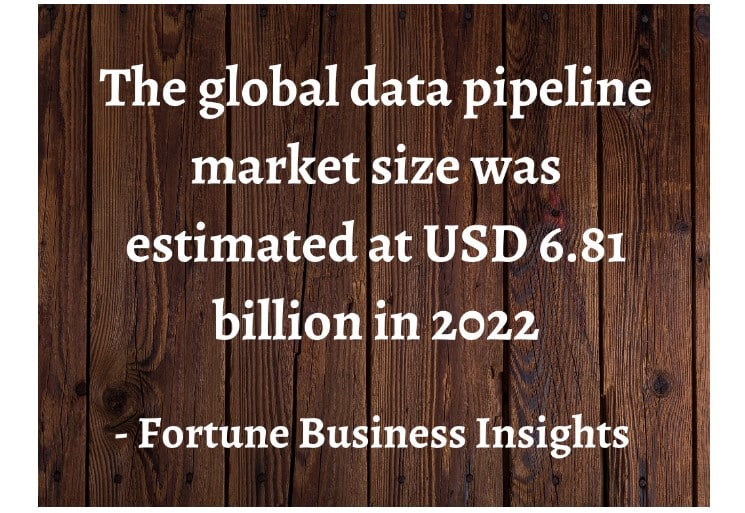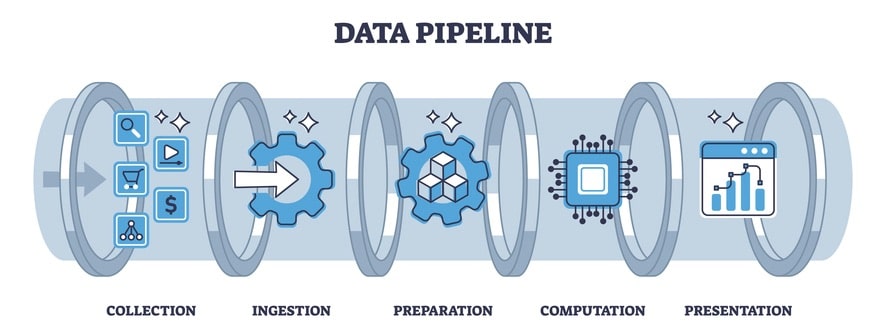A marketing data pipeline serves as the foundation for any modern, data-driven business in the world today. It allows for the easy and seamless flow of information, all the way from source to destination, not unlike a well-serviced car. The pipeline consists of various tools that work together, and various processes.
These play a vital role, both in transporting data and refining it so that it can be used and analyzed meaningfully. In this article, we will cover the main things you need to know about marketing data pipelines and why you need one for your place of work.

Understanding data pipelines
A data pipeline moves data from its source to its destination, like a conveyor belt in a car manufacturer. This process involves a web of interconnected tools and movements that work together in order to move data as well as transform it so that it can be used and analyzed.
The various steps of the process involve particular functions, such as quality control and allocation. The result is that the data is delivered in its most optimal form.
Raw data is taken and turned into meaningful information that can be analyzed and used, for example, to decide how social media should be harnessed for your business.
The steps involved include extraction from the source, transformation of the data into the relevant structure and format, and entering, or loading, the data into storage systems to be analyzed. This is known as ETL: extract, transform, and load.
Data pipeline components
Data pipelines consist of a series of technical components that work together to move along and transform the data. These components include:
- The data source: the data source is the first part of the data pipelines, and it can consist of a CRM system, a database, and web analytics.
- Data processing engine: the processing engine will apply rules to raw data and transform it into a meaningful and usable format.
- Data storage tool: This is the destination, and it can consist of a data warehouse or data lake where the information is stored in its usable format in order to undergo analysis (look at data lake best practice examples for guidance).
- Data orchestration software: this software is used to manage the workflow and the movement of the data through the pipeline.
7 reasons why you need a marketing data pipeline
If you work in PR, a marketing data pipeline is an invaluable resource for your business. With its ability to collect and store valuable marketing info in one, easy-to-access space, various members of your team can access high-quality and meaningful data to do their jobs and analyze brand reputation, for example.
It also enables cross-departmental collaboration with the centralization of data, so you can more easily work with your colleagues outside of your marketing team.

Image created by author: statistic source
Additional reasons why a marketing data pipeline would benefit your company include:
1. Enhanced decision-making
With increasing numbers of decisions becoming data-driven, whether it’s deciding how to market your product or what to stock based on supply chain forecasting methods, a data pipeline can help you to make the most informed choices. You can use data for creating stellar marketing strategies, analyzing your performance, and understanding your audience.
You want your decisions to be data-driven in order to make the best use of your time and resources; easy access to refined data in a central location is ideal.
2. Easier analysis
Since a data pipeline centralizes all of your marketing data from different sources into one platform, this makes it much easier to access your outbound sales leads data in one place, for example, and to analyze that data. It comes in one format, in a place where all of your colleagues can easily access it, so comparing reports and basing your analysis on the same dataset becomes much easier.
A marketing data pipeline can allow you to integrate data from various sources, such as social media, website analytics, CRM systems, and more, into a centralized platform. This centralized data hub allows for a comprehensive view of all marketing activities and performance metrics.
3. Improved data quality
Automating your data collection, processing, and storage, as well as the data cleaning and validation processes, improves the quality of your data. This in turn allows your business to be certain that the data they’re using is accurate and reliable.

Your data can be improved by:
- Data standardization: the pipeline standardizes data, using Parquet data formats for example, and standardizes structures regardless of the source, ensuring consistency and accuracy.
- Data cleaning: You can use your pipeline to clean and validate data automatically, as well as remove inconsistencies, any values that are missing, and any data outliers.
- Data enrichment: You can add new data to existing datasets to enrich your dataset, improving the depth and quality of your knowledge base.
- Removing duplicates: You can use the pipeline to identify and remove duplicate records. This keeps your data accurate and clean for you to use.
- Data security: You can ensure that data security standards are adhered to throughout the pipeline process in order to meet regulations.
4. Real-time insights
With a data pipeline for your marketing business, you can enjoy real-time engagement rate data updates as well as performance metrics through continuous and automated data processing. This allows you to respond quickly to changing market conditions and consumer behavior trends so that you stay on top of your game.
Real-time insights are crucial for understanding customer behavior trends and optimizing marketing strategies. Whether it’s tracking email open rates or analyzing click-through rates on email campaigns, a marketing data pipeline provides continuous updates on email marketing performance, enabling quick adjustments to ensure maximum engagement and effectiveness.

Furthermore, to effectively communicate these insights within your organization or to stakeholders, consider leveraging visualization tools. You could use an AI infographic maker to showcase your survey results. This approach enhances comprehension and engagement by presenting complex data in an easily digestible format, facilitating better understanding and informed decision-making.
The insights you gather through analyzing the data can be presented through reports and visualizations such as charts, which allows you and your colleagues to make quick decisions about marketing, or decide whether composable commerce is a good fit for the company, for example.
You can streamline the pipeline processes as well as use tools such as machine learning and cloud computing in order to make the most out of your marketing data pipeline. The real-time insights can help you optimize your campaigns, personalize your messaging, and generally enhance the performance of your PR company.
5. Efficiency and scalability
You can automate your data processing tasks with marketing data pipelines. This efficiency allows your business to scale up or down with greater ease. It also means that data transformation, enrichment, and storage can go on in the background so that you can free up your time on creative tasks.
Integrating tools like Person Search can further enhance your data enrichment processes, providing additional demographic insights and contact details. This enriched data allows for more targeted and personalized marketing strategies, ultimately leading to improved campaign effectiveness and customer engagement.
It also allows PR companies to handle large amounts of data, which is essential for this business area.
6. Competitiveness
Being able to make the most of your data can help you to get a leg up over the competition.
A marketing data pipeline can assist your business with making the best use of your data and gaining a competitive advantage with practices such as media monitoring, for example. This information and knowledge can help you to offer amazing customer service, find innovative solutions, and optimize your workflow.

7. A gateway to technological advancement
With so many technological advances (looking at you, iPaaS solution!), you can use a data pipeline to help you process large amounts of data and make use of things like AI and machine learning, which also require large amounts of data.
This puts your company on a level playing field with other companies in your profession so you don’t end up at a disadvantage.
Final thoughts
To summarize, a marketing data pipeline is vital when it comes to transporting, transforming, and analyzing data in a way that saves time and money. Raw data is extracted and transformed and then loaded into data centers, which allows PR business to glean meaningful and actionable insights from the data.
Different components, such as the data source, processing engine, storage tool, and orchestration software, work in harmony. For PR professionals in particular, a marketing data pipeline offers improved decision-making, easier analysis, enhanced data quality, real-time insights, and increased efficiency. By harnessing the power of a marketing data pipeline, you can enhance your performance, and stay agile in a competitive market.








